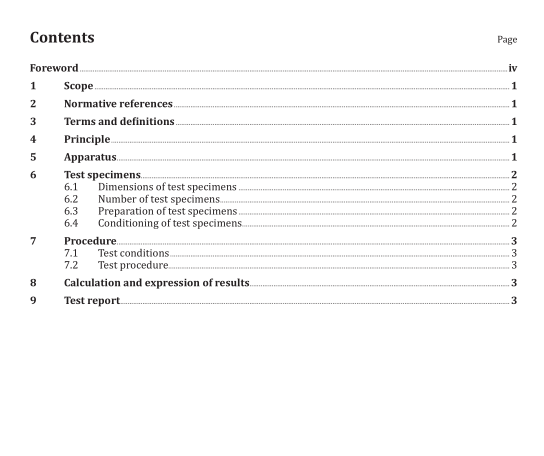EN ISO 29470:2020 pdf download.Thermal insulating products for building applications – Determination of the apparent density (ISO 29470:2020)
6 Test specimens
6.1 Dimensions of test specimens
The test specimens shall be full-size products or parts of them or test specimens used for other tests.
The shape of the test specimens shall be such that their volume can be easily calculated.
When the apparent overall density is being determined using test specimens cut from a product with surface skins formed during production, the ratio of the area of the surface skin to the total volume for the test specimen shall be the same as the product.
When the shape or surface of the product is not rectangular and easy to measure and calculate, a representative piece of the product shall be cut out.
The size of a test specimen should be as large as possible, commensurate with the apparatus available and with the shape of the original product. The size of the test specimens may also be specified in other test methods.
6.2 Number of test specimens
The number of test specimens for full-size products shall be as specified in the relevant product standard. If test specimens from other tests are used, the number shall be as specified in the test method. If the number is not specified, then at least five test specimens shall be used.
In the absence of a product standard or any other technical specification, the number of test specimens may be agreed between parties.
6.3 Preparation of test specimens
The test specimens shall be cut using a method that does not change the original structure of the product.
The location from which the test specimens are taken shall be such that the density obtained is representative of the density of the product.
For determining the apparent overall density, any facings and/or coatings shall be removed from the product.
For determining the apparent core density, any surface skins formed during production and any facings and/or coatings shall be removed from the product.
When it is not possible to remove the facings and/or coatings without influencing the apparent density of the product, the mass of the facings and/or coatings shall be deducted by calculation.
NOTE Special methods of preparation, when needed, are given in the relevant product standard.
6.4 Conditioning of test specimens
The specimens shall be conditioned at (23 ± 2) °C and (50 ± 5) % relative humidity (RH) until constant mass is achieved.
The time for conditioning and the required accuracy of the constant mass measurements shall be given in the relevant product standard.
If it can be shown that temperature and humidity have negligible influence on the determination of the density, then the conditioning may be carried out at (23 ± 5) °C.
The conditioning time can be shortened by pre-drying the specimen in a ventilated oven at a prescribed temperature. Appropriate procedures may be given in the relevant product standard.
In tropical countries different conditioning and testing conditions may be more relevant. In such cases,the conditions shall be 27° C/65 % RH and be stated clearly in the test report.
7 Procedure
7.1 Test conditions
The test shall be carried out at (23 ± 2) °C and (50 ± 5) % RH.
If it can be shown that temperature and humidity have negligible influence on the determination of the density, testing may be carried out at (23 ± 5) °C.
In tropical countries different conditioning and testing conditions may be more relevant. In such cases,the conditions shall be (27 ± 2) °C/(65 ± 5) % RH and be stated clearly in the test report.
7.2 Test procedure
Measure the linear dimensions of full-size products in accordance with ISO 29465 and ISO 29466.
Measure the linear dimensions of specimens in accordance with ISO 29768.
For full-size products, the length, width and thickness shall be given to the nearest millimetre (mm).
For specimens, the measurements shall be made to an accuracy of 0,5 %.
Calculate the volumes of the test specimens from these measurements.
Weigh each test specimen to an accuracy of 0,5 % and record its mass in kilograms (kg).
If the facings and/or coatings are retained, the mass of the product shall be calculated by deducting the mass of the facings and/or coatings and adhesives, if any, from the overall mass.
If a greater accuracy for dimensions of full-size products is needed, this shall be specified in the relevant product standard.EN ISO 29470 pdf download.EN ISO 29470 pdf download
